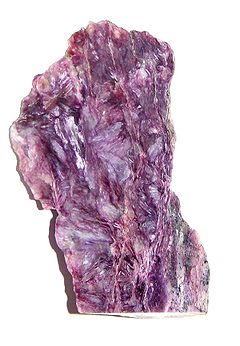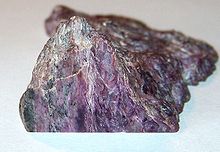- Charoite
-
Charoite 
General Category Silicate mineral Chemical formula K(Ca;Na)2Si4O10(OH;F)·H2O Identification Color Violet, lilac, light brown Crystal habit Fibrous, massive Crystal system Monoclinic - Prismatic 2/m Cleavage Good in three directions Mohs scale hardness 5 - 6 Luster Vitreous to pearly Streak White Diaphaneity Translucent Specific gravity 2.54 - 2.58 Optical properties Biaxial (+) Refractive index nα = 1.550 nβ = 1.553 nγ = 1.559 Birefringence δ = 0.009 Other characteristics Weakly fluorescent References [1][2][3] Charoite (K(Ca;Na)2Si4O10(OH;F)·H2O)[3], pronounced CHAR-oh-ite, is a rare mineral, first described in 1978 and named for the Chara River.[2] It has been reported only from the Sakha Republic, Yakutia, Siberia, Russia.[3] It is found where a syenite, the Murunskii Massif, has intruded into and altered limestone deposits producing a potassium feldspar metasomatite.[1][2]
Charoite is translucent lavender to purple in color with a pearly lustre. However, it is a discrete mineral rather than a rock. Charoite is strictly massive in nature, and fractures are conchoidal. It has an unusual swirling, fibrous appearance, sometimes chatoyant, and that, along with its intense color, can lead many to believe at first that it is synthetic or enhanced artificially.
Though reportedly discovered in the 1940s, it was not known to the outside world until its description in 1978. It is said to be opaque and unattractive when found in the field; a fact that may have contributed to its late recognition. Charoite is used as an ornamental stone and sometimes a gemstone, generally as cabochons set into pendants.[citation needed]
Charoite occurs in association with tinaksite and canasite.[3]
References
- ^ a b http://www.webmineral.com/data/Charoite.shtml Charoite info at WebMineral
- ^ a b c http://www.mindat.org/show.php?id=972&ld=2&pho= Mindat
- ^ a b c d http://rruff.geo.arizona.edu/doclib/hom/charoite.pdf Mineral Handbook
Categories:- Calcium minerals
- Sodium minerals
- Potassium minerals
- Inosilicates
- Gemstones
- Monoclinic minerals
Wikimedia Foundation. 2010.

